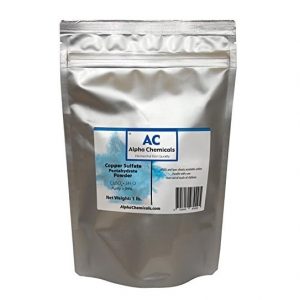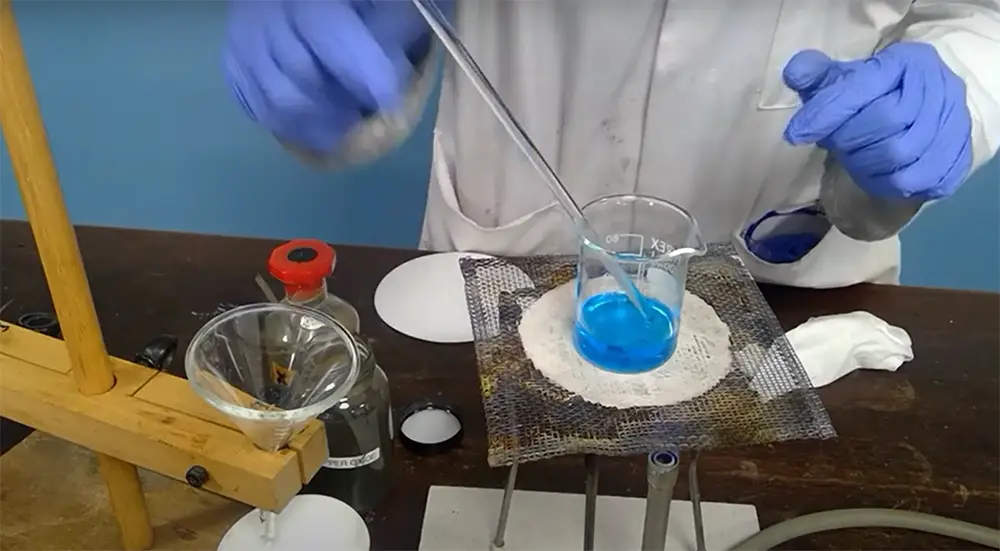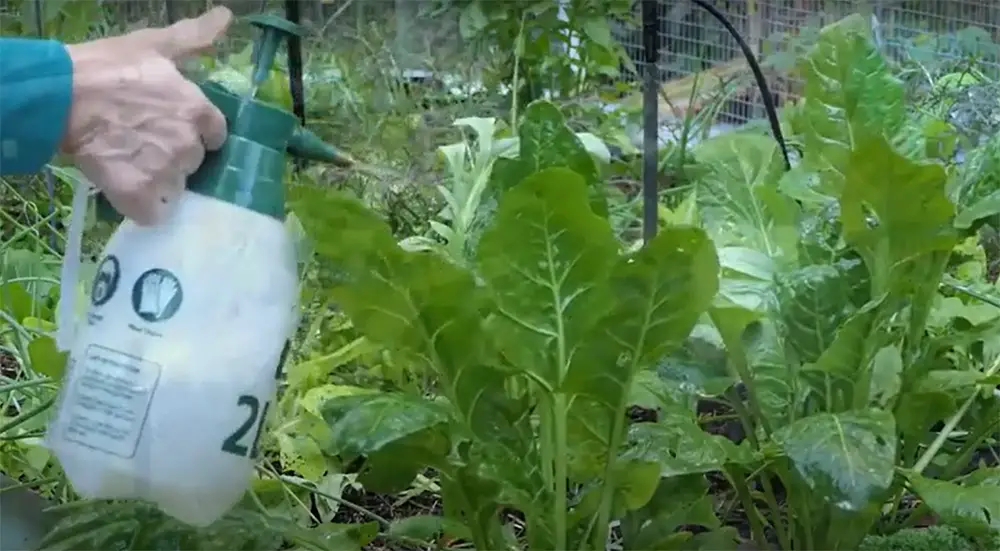Copper sulfate is a chemical compound that contains copper and sulfur. It’s also known as “blue stone” because of its deep blue color. Copper sulfate can be used to kill weeds, algae, fungi, and pests in gardens without harmful side effects to the soil or nearby plants.
Copper sulfate has been used in gardening for many years. This chemical can be applied to plants to control various problems such as algae, fungi, and moss. Copper sulfate is also an effective weed killer when mixed with other chemicals or sprayed onto the soil where weeds grow.

Copper sulfate is also effective against pests such as aphids, whiteflies, spider mites, and scale insects. When used as a foliar spray, it can help to control these pests without harming beneficial insects. Copper sulfate can be purchased at most garden stores or online retailers.
How Does Copper Sulfate Affect Garden Plants?
There are many reasons why gardeners would like to know how does copper sulfate affects garden plants. Copper is a natural mineral that aids in the growth of healthy and beautiful vegetables, fruits, and flowers. Sulfate is a compound that helps copper become more available to plants. When these two are combined, they create an excellent fertilizer for gardens.
The application of copper sulfate in the garden can be done through foliar feeding or soil drenching. For foliar feeding, mix one tablespoon of copper sulfate with one gallon of water and spray on the leaves of the plants. Do this once a week until you see desired results.

Always follow the directions on the label when using copper sulfate in your garden. When handling this chemical, wear gloves and safety equipment, and avoid breathing in the dust or fumes. Keep children and pets away from areas where copper sulfate has been applied. Copper sulfate should not be used near water sources such as ponds or streams since it can harm aquatic life [1].
Acting as a Fertilizer
Copper shortages can also cause stunted development; plants in extremely mineral-deficient soils are more likely to die prematurely. Wilting of failing blooms, as well as lower fruit production, are all possible consequences of copper-poor soil.
In order to make sure that the copper sulfate is not too strong, try diluting it with water. Mix one tablespoon of copper sulfate per gallon of water before spraying your plants. Start by testing a small area on the plant first and wait 24 hours to see if there are any adverse effects such as leaf burning or stippling.
In soils with high levels of organic material, the application of too much copper can be toxic to plants and may cause them to die from root burn. In order to avoid this, only use a quarter teaspoon per plant for 3 weeks during the growing season if using it as a fertilizer. When used in soil that is already rich in trace minerals, adding more copper will have no effect on your garden’s growth rate.
Copper sulfate is a substance that can be used to cure and prevent copper deficiency. Annually, you should check the soil and apply copper sulfate as needed in a spray or fertilizer solution. Foliar applications must be renewed every year, but adding copper sulfate to the soil is a long-term strategy [2].
Acting as an Antifungal
Copper sulfate is a common primary component in certain commercial fungicides. These fungicides are usually combined with water and lime or soda ash, then sprayed onto the plants to achieve maximum effectiveness.
Copper sulfate is usually effective against a wide range of fungal pathogens, such as Alternaria, Aspergillus, Botrytis, Cladosporium, Fusarium, Monilinia, and Penicillium.
When using copper sulfate as an antifungal, always follow the instructions on the label. Be sure to wear gloves and protective clothing when handling this chemical, and avoid breathing in the dust or fumes. Keep children and pets away from areas where copper sulfate has been applied. Do not apply copper sulfate near water sources such as ponds or streams.
In order to be most effective, fungicides containing copper sulfate should be used preventatively; that is before infection occurs.

Effects on Different Fruit
Copper has the potential to alter fruit sugar content and flavor in fruiting or flowering plants. Inhibition of photosynthesis, chlorophyll degradation, and oxidative stress are the main factors that copper ions cause to plants. The application of copper sulfate as a foliar spray can control powdery mildew, Phytophthora blight, Botrytis bunch rot, and other diseases on fruit crops in commercial agriculture.
The effects of copper sulfate spray application are most apparent in blueberry, tomato, watermelon, onion, parsnip, lettuce, beet, carrot, cabbage, eggplant, celery, spinach plants. When a plant’s conductivity is lowered due to water accumulation inside its leaves, the taste becomes sweeter.
Excess copper sulfate raises conductivity, lowering the sugar concentration and flavor intensity of the fruit. If you want to cultivate sweet fruits that aren’t watery, make sure you’re not applying too much copper sulfate to your plants [3].
Forms of Copper for Slug Control
The most simple types to employ are copper barriers. These may only protect a slug-free bed or planter box, including eggs. To accomplish this you will need some copper stripping and a metal tape measure. Remove the measuring tape from its holder, then bend it into an S-shape that can be placed in flowerbeds or around individual plants to protect them.
Copper barriers are also effective against slugs for internal intrusion, but they must be secured well enough not to fall over during rainstorms. You could use these barriers on pathways that lead underneath plants where slugs like to hide after dark since their slime trails left behind indicate slug activity.
The Bordeaux mixture is another form of copper that may be utilized to battle these chewing pests. It is a fungicide made of hydrated lime and copper sulfate, which can be sprayed on plants.
It should be applied every seven to ten days when the temperature is below 85 degrees Fahrenheit, and it will protect your plants from powdery mildew, black rot, anthracnose, and other fungal diseases.
When using copper sulfate in your garden for pest control always mix it with water at a rate of about four teaspoons per gallon for spraying. You may also use Bordeaux mixture as a soil drench around susceptible plants. Check the weather forecast before applying because rain soon after application will wash the chemical away and you’ll need to reapply it [4].

How to Use Copper Sulfate as a Fungicide:
Fungi feed on plants, stealing minerals in the process. They attack and destroy plant cells, resulting in the decline and eventual death of the plant if they are left unchecked.
The correct ratio is essential since too much may also be harmful to plants [5]:
- Make a copper sulfate solution. 3 tablespoons of copper sulfate are mixed with a gallon of water to make 1 quart (approx. 1 liter) of solution. Stir until completely dissolved;
- Add 3 tablespoons of hydrated lime to the mixture and stir until completely dissolved;
- Pour the mixture into a pump-up sprayer. Spray the fungus-infected areas of the plant until they are fully covered. To prevent harming healthy portions of the plant, do not spray to areas that aren’t infected;
- Repeat the procedure in two weeks if the plant is still infested with fungus;
How to Use Copper Sulfate in the Garden: A Comparative Guide
Copper sulfate is a versatile chemical compound used in gardens to control and prevent various fungal and bacterial diseases in plants. Its effectiveness and safety depend on several factors. In this table, we compare the different indicators of using copper sulfate in the garden to help you make informed decisions.
| Indicator | Effectiveness | Safety | Application Frequency | Environmental Impact |
|---|---|---|---|---|
| Control of Fungal Diseases | High | Moderate | Periodic (as needed) | Low (with proper usage) |
| Control of Bacterial Diseases | Moderate | Moderate | Periodic (as needed) | Low (with proper usage) |
| Moss and Algae Control | High | Low | Once or Twice a Year | Low (if used in recommended amounts) |
| Soil Acidification | Low | Moderate | Occasional (with pH testing) | Medium (can increase soil acidity) |
| Aquatic Plant Control | High | Low | Once or Twice a Year | Low (when used as directed) |
Explanation of the Table:
- Effectiveness: This column rates how well copper sulfate performs in controlling different garden issues. It is highly effective against fungal diseases and aquatic plants, while moderately effective against bacterial diseases and moss/algae.
- Safety: The safety of using copper sulfate lies between low to moderate. While it can pose some risks if not handled properly, following recommended guidelines can mitigate hazards.
- Application Frequency: This column indicates how often you should apply copper sulfate. It varies depending on the issue, with periodic use for disease control and less frequent application for moss, algae, and aquatic plant control.
- Environmental Impact: Copper sulfate has a low to medium environmental impact. When used correctly, it can be relatively safe for the environment, but overuse may lead to increased soil acidity and potential harm to aquatic ecosystems.
Using copper sulfate in the garden can be a useful tool for disease and pest control, but it should be applied with caution and according to recommended guidelines to ensure its effectiveness and minimize potential risks. Always read and follow the product label instructions to use copper sulfate safely and responsibly.
FAQ
Is copper sulfate safe to use on vegetables?
Newer copper alloys have been found to be less harmful to plants and fruits. Some toxicity may still exist in some cases. Fungicides containing copper work by denaturing enzymes and other important proteins, as well as destroying pathogen cells. If enough copper is absorbed, it can also harm plant cells.
Copper sulfate is a very safe mineral, readily dissolving in water and combining with lime to stabilize the copper. It’s safe to use on plants because it doesn’t cause tissue damage when combined with lime [6].
How do you mix copper sulfate for plants?
Spraying on all the aerial parts of the plants, in the leaves, should be done in both the top and bottom.
A spray, water, and copper sulfate are all you need to make the product. To prepare the solution – 20 grams of copper sulfate must be combined in a liter of water and sprayed onto the plants. It’s vital to have the correct amount of medicine on hand since this lotion doesn’t last long and should only be used once. The compound will lose its healing qualities if you store it for longer than a day, therefore you must prepare the required quantity. This product is not harmful to plants, but it is poisonous for people and pets in the home, so use caution when applying it to plants and avoid contact with pets and children [7].
Is copper sulfate good for tomatoes?
Copper sulfate, formerly employed by vintners in the Bordeaux area of France to keep mold and other fungi off their grapes, is still effective for that purpose when used on certain fruits and vegetables, such as tomatoes [8].
How do you apply copper sulfate to fruit trees?
The copper sulfate fungicide should be applied at the same time as the fruit trees are ready to pick. The timing of application is just as important, if not more so than correctly applying copper sulfate when it comes to ensuring that the fungicide works properly without harming the fruit trees.
Depending on the type, brand, illnesses to be controlled, and species of fruit tree being treated, preparing the copper sulfate varies.
For example, one type of wettable powder instructs filling a pump spray tank 1/3 full with water before adding 5.6 ounces of the fungicide. Combine the components and add the remaining water until the tank is full. This combination will treat approximately 10,000 square feet and eliminate black rot on apple trees that are grown in USDA plant hardiness zones 4 through 8 (Malus Domestica) [9].
What is the purpose of using copper sulfate in the garden?
Copper sulfate is often used in the garden to control fungal diseases, algae, and moss. It acts as a fungicide and algaecide, helping to protect plants and prevent certain pests.
How do I use copper sulfate to control fungal diseases?
To control fungal diseases in your garden, dissolve copper sulfate in water according to the package instructions and then spray it on the affected plants. It helps in preventing and treating diseases like blight, mildew, and rust.
Can copper sulfate be used as a soil amendment?
Yes, copper sulfate can be used as a soil amendment in certain situations. It can help correct copper deficiencies in the soil, but it should be used sparingly as excessive use can be harmful to plants and soil organisms.
When is the best time to apply copper sulfate to my garden?
Copper sulfate is best applied during the dormant season or early spring before new growth begins. This timing helps to prevent diseases and address any overwintering issues effectively.
How do I prevent copper sulfate from harming beneficial insects?
To avoid harming beneficial insects like bees and ladybugs, it’s essential to apply copper sulfate during times when these insects are not active, such as in the early morning or late evening. Additionally, focus on targeting the application to the affected areas only.
Can I use copper sulfate to treat root rot in plants?
Copper sulfate can be used as a treatment for root rot in plants, but it is essential to use it in the appropriate concentration and as a preventative measure. It won’t cure root rot once it has already set in significantly.
How often should I apply copper sulfate to my garden?
The frequency of copper sulfate application depends on the specific product and the severity of the problem you are addressing. In most cases, it is recommended to apply it every 7 to 10 days during the growing season for effective disease prevention.
Are there any alternatives to copper sulfate for disease control?
Yes, there are alternative methods for disease control in the garden. Some organic options include neem oil, baking soda sprays, and potassium bicarbonate, which can effectively combat fungal diseases without the potential environmental risks of copper sulfate.
Can I use copper sulfate in hydroponic or aquaponic systems?
It is not recommended to use copper sulfate in hydroponic or aquaponic systems, as it can be harmful to fish and other aquatic organisms. Instead, explore alternative methods for disease and pest control in these systems.
What safety precautions should I take when using copper sulfate in the garden?
When using copper sulfate, wear protective clothing, gloves, and eyewear to avoid direct contact with the skin and eyes. Keep children and pets away from treated areas until the product has dried. Always follow the manufacturer’s instructions for safe handling and use.
Useful Video: How to Use Copper Sulfate As a Fungicide
References:
- https://homeguides.sfgate.com/effects-copper-sulfate-plants-27633.html
- https://www.copper.org/resources/properties/compounds/copper_sulfate02.html
- https://homeguides.sfgate.com/effects-copper-sulfate-plants-27633.html
- https://www.gardeningknowhow.com/garden-how-to/info/using-copper-in-gardening.htm
- https://www.hunker.com/13406855/how-to-use-copper-sulfate-as-a-fungicide
- https://www.gardeningknowhow.com/garden-how-to/info/using-copper-in-gardening.htm
- https://www.macrobonsai.com/how-to-use-copper-sulfate-in-gardens
- https://www.ehow.com/how_8041895_spray-tomatoes-copper-sulfate.html
- https://homeguides.sfgate.com/should-copper-sulfate-fruit-trees-92720.html










When I was first starting out in gardening, I was given a lot of advice from experienced gardeners. One piece of advice that I found very helpful was how to add copper to soil naturally. Copper sulfate is a naturally occurring mineral that is beneficial to plants. It helps to improve root growth, assists in the uptake of nutrients, and helps to protect plants from disease.
To add copper sulfate to your soil, you can either purchase it at a garden center or make your own. To make your own, simply dissolve 1 cup of copper sulfate in 1 gallon of water. Then, pour the mixture around the base of your plants. Be sure to avoid getting the mixture on the leaves of your plants, as it can be harmful.